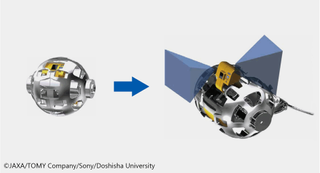Japan's SLIM moon lander is carrying this transforming ball robot (it's not BB-8)
The little rolly-polly probe will hobble and wheel itself around to take pictures of the SLIM lander on the moon.

Japan's recent launch of the SLIM moon lander included a tiny lunar explorer inspired by a children's toy.
The Lunar Excursion Vehicle 2 (LEV-2) is a little metal sphere, not much larger than a tennis ball. Once on the moon, it will pop off the SLIM lander, and transform its two halves to traverse the fine regolith of the lunar surface.
SLIM, the Smart Lander for Investigating Moon probe from the Japanese space agency JAXA, is designed to demonstrate the country's first soft lunar landing. It launched aboard an H-2A rocket on Wednesday (Sept. 6) with a sister payload, the XRISM X-ray satellite.
Related: Japan launches SLIM moon lander, XRISM X-ray telescope on space doubleheader (video)
SLIM, a relatively small spacecraft, measuring less than 9 feet (2.4 meters) across, will spend the next few months reaching lunar orbit. It will spend another month surveying its landing site inside the moon's Shioli Crater.
Assuming SLIM's descent goes as planned, LEV-2 will release from the lander at approximately 5 feet, 11 inches (1.8 meters) above the lunar surface, and begin rolling around to image SLIM's landing and the surrounding area. LEV-2's battery power is expected to last about two hours.
When the two halves of LEV-2 separate, they are able to function as legs and wheels to allow the tiny probe to move around. Nestled between the halves are two cameras and a stabilizer used to help LEV-2 navigate its surroundings. As it does, it will transmit its data back to Earth through LEV-1, a separate probe also aboard SLIM, which will operate in tandem with SLIM and LEV-2.
Get the Space.com Newsletter
Breaking space news, the latest updates on rocket launches, skywatching events and more!
The video below demonstrates how LEV-2 will propel itself across the lunar surface (but note that the video is in Japanese only).
HIRANO Daichi developed LEV-2 at JAXA, and worked with toy manufacturer Tomy and researchers at Doshisha University to design the probe with the same shape-changing mechanics used in children's toys, and with Sony Group to develop the cameras.

"We adopted the robust and safe design technology for children's toys, which reduced the number of components used in the vehicle as much as possible and increased its reliability," Daichi explained in a JAXA press release. Those technologies also helped reduce the size of LEV-2 to satisfy the size constraints of flying aboard the SLIM lander.
"This robot was developed successfully within the limited size and mass using the downsizing and weight reduction technologies and the shape changing mechanism developed for toys by TOMY and Doshisha University as well as the small and energy-efficient control board and camera developed by Sony Group," Daichi said, adding, that he hopes children will be inspired by the diminutive roboball and become interested in science.
Join our Space Forums to keep talking space on the latest missions, night sky and more! And if you have a news tip, correction or comment, let us know at: community@space.com.

Josh Dinner is Space.com's Content Manager. He is a writer and photographer with a passion for science and space exploration, and has been working the space beat since 2016. Josh has covered the evolution of NASA's commercial spaceflight partnerships, from early Dragon and Cygnus cargo missions to the ongoing development and launches of crewed missions from the Space Coast, as well as NASA science missions and more. He also enjoys building 1:144 scale models of rockets and human-flown spacecraft. Find some of Josh's launch photography on Instagram and his website, and follow him on Twitter, where he mostly posts in haiku.
